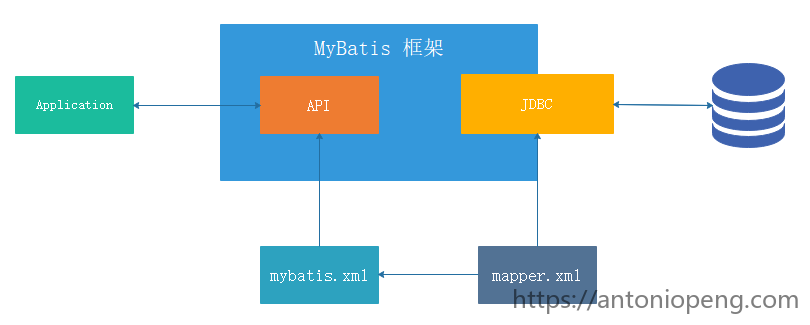MyBatis 简介
MyBatis 是一个基于 Java 的持久层框架,它内部封装了 JDBC,使开发者只需关注 SQL 语句本身,而不用再花费精力去处理诸如注册驱动、创建 Connection、配置 Statement 等繁杂过程。
Mybatis 通过 xml 或注解的方式将要执行的各种 Statement、PreparedStatement 等配置起来,并通过 Java 对象和 Statement 中 SQL 的动态参数进行映射生成最终执行的 SQL 语句,最后由 MyBatis 框架执行 SQL 并将结果映射成 Java 对象并返回。
MyBatis 与 Hibernate
Hibernate 框架是提供了全面的数据库封装机制的 全自动 ORM,即实现了 POJO 和数据库表之间的映射,以及 SQL 的自动生成和执行。
相对于此,MyBatis 只能算作是 半自动 ORM。其着力点,是在 POJO 类与 SQL 语句之间的映射关系。也就是说,MyBatis 并不会为程序员自动生成 SQL 语句。具体的 SQL 需要程序员自己编写,然后通过 SQL 语句映射文件,将 SQL 所需的参数,以及返回的结果字段映射到指定 POJO。
MyBatis 特点
- 在
XML文件中配置SQL语句,实现了SQL语句与代码的分离,给程序的维护带来了很大便利。 - 可以结合数据库自身的特点灵活控制
SQL语句,因此能够实现比Hibernate等全自动ORM框架更高的查询效率,能够完成复杂查询。

Spring 整合 Mybatis
引入依赖
在 pom.xml 引入 Mybatis 相关依赖。
<dependency>
<groupId>org.mybatis</groupId>
<artifactId>mybatis</artifactId>
<version>3.2.8</version>
</dependency>
<dependency>
<groupId>org.mybatis</groupId>
<artifactId>mybatis-spring</artifactId>
<version>1.3.1</version>
</dependency>
<dependency>
<groupId>org.springframework</groupId>
<artifactId>spring-jdbc</artifactId>
<version>4.3.17.RELEASE</version>
</dependency>
创建 Mybatis 配置文件
在 resource 目录下创建 mybatis-config 配置文件。
<?xml version="1.0" encoding="UTF-8"?>
<!DOCTYPE configuration PUBLIC "-//mybatis.org//DTD Config 3.0//EN" "http://mybatis.org/dtd/mybatis-3-config.dtd">
<configuration>
<!-- 全局参数 -->
<settings>
<!-- 打印 SQL 语句 -->
<setting name="logImpl" value="STDOUT_LOGGING" />
<!-- 使全局的映射器启用或禁用缓存。 -->
<setting name="cacheEnabled" value="false"/>
<!-- 全局启用或禁用延迟加载。当禁用时,所有关联对象都会即时加载。 -->
<setting name="lazyLoadingEnabled" value="true"/>
<!-- 当启用时,有延迟加载属性的对象在被调用时将会完全加载任意属性。否则,每种属性将会按需要加载。 -->
<setting name="aggressiveLazyLoading" value="true"/>
<!-- 是否允许单条 SQL 返回多个数据集 (取决于驱动的兼容性) default:true -->
<setting name="multipleResultSetsEnabled" value="true"/>
<!-- 是否可以使用列的别名 (取决于驱动的兼容性) default:true -->
<setting name="useColumnLabel" value="true"/>
<!-- 允许 JDBC 生成主键。需要驱动器支持。如果设为了 true,这个设置将强制使用被生成的主键,有一些驱动器不兼容不过仍然可以执行。 default:false -->
<setting name="useGeneratedKeys" value="false"/>
<!-- 指定 MyBatis 如何自动映射 数据基表的列 NONE:不映射 PARTIAL:部分 FULL:全部 -->
<setting name="autoMappingBehavior" value="PARTIAL"/>
<!-- 这是默认的执行类型 (SIMPLE: 简单; REUSE: 执行器可能重复使用prepared statements语句;BATCH: 执行器可以重复执行语句和批量更新) -->
<setting name="defaultExecutorType" value="SIMPLE"/>
<!-- 使用驼峰命名法转换字段。 -->
<setting name="mapUnderscoreToCamelCase" value="true"/>
<!-- 设置本地缓存范围 session:就会有数据的共享 statement:语句范围 (这样就不会有数据的共享 ) defalut:session -->
<setting name="localCacheScope" value="SESSION"/>
<!-- 设置 JDBC 类型为空时,某些驱动程序 要指定值, default:OTHER,插入空值时不需要指定类型 -->
<setting name="jdbcTypeForNull" value="NULL"/>
</settings>
</configuration>
创建集成配置文件
在 resource 目录下创建一个 spring-context-mybatis.xml 的集成配置文件。
<?xml version="1.0" encoding="UTF-8"?>
<beans xmlns="http://www.springframework.org/schema/beans" xmlns:xsi="http://www.w3.org/2001/XMLSchema-instance"
xsi:schemaLocation="http://www.springframework.org/schema/beans http://www.springframework.org/schema/beans/spring-beans.xsd http://www.springframework.org/schema/tx http://www.springframework.org/schema/tx/spring-tx.xsd">
<!-- 配置 SqlSession -->
<bean id="sqlSessionFactory" class="org.mybatis.spring.SqlSessionFactoryBean">
<property name="dataSource" ref="dataSource"/>
<!-- 用于配置对应实体类所在的包,多个 package 之间可以用 ',' 号分割 -->
<property name="typeAliasesPackage" value="com.antoniopeng.ssm.domain"/>
<!-- 用于配置对象关系映射-->
<property name="mapperLocations" value="classpath:/mapper/**/*.xml"/>
<!-- -用于配置文件所在目录->
<property name="configLocation" value="classpath:/mybatis-config.xml"></property>
</bean>
<!-- 扫描 Mapper -->
<bean class="org.mybatis.spring.mapper.MapperScannerConfigurer">
<property name="basePackage" value="com.antoniopeng.ssm.dao" />
</bean>
</beans>
CRUD 案例
新增
<insert id="insert">
INSERT INTO tb_user (
id,
username,
password,
phone,
email,
created,
updated
)
VALUES
(
#{id},
#{username},
#{password},
#{phone},
#{email},
#{created},
#{update}
)
</insert>
删除
<delete id="delete">
DELETE FROM tb_user WHERE id = #{id}
</delete>
查询
<select id="getById" resultType="TbUser">
SELECT
a.id,
a.username,
a.password,
a.phone,
a.email,
a.created,
a.updated AS "update"
FROM
tb_user AS a
WHERE
a.id = #{id}
</select>
更新
<update id="update">
UPDATE
tb_user
SET
username = #{username},
password = #{password},
phone = #{phone},
email = #{email},
created = #{created},
updated = #{update}
WHERE id = #{id}
</update>
MyBatis 动态 SQL
动态 SQL 主要用于解决查询条件不确定的情况:在程序运行期间,根据用户提交的查询条件进行查询。提交的查询条件不同,执行的 SQL 语句不同。若将每种可能的情况均逐一列出,对所有条件进行排列组合,将会出现大量的 SQL 语句。此时,可使用动态 SQL 来解决这样的问题。这里的条件判断使用的表达式为 OGNL 表达式。常用的动态 SQL 标签有 <if>、<where>、<choose>、<foreach> 等。
注意:在 mapper 的动态 SQL 中若出现 >、<、>=,<= 等符号,最好将其转换为实体符号。否则,XML 可能会出现解析出错问题,特别是 < 在 XML 中是绝对不能出现的。
if 标签
对于该标签的执行,当 test 的值为 true 时,会将其包含的 SQL 片断拼接到其所在的 SQL 语句中。
案例
为了解决两个条件均未做设定的情况,在 where 后添加了一个“1=1”的条件。这样就不至于两个条件均未设定而出现只剩下一个 where,而没有任何可拼接的条件的不完整 SQL 语句。
<?xml version="1.0" encoding="UTF-8" ?>
<!DOCTYPE mapper PUBLIC "-//mybatis.org//DTD Mapper 3.0//EN" "http://mybatis.org/dtd/mybatis-3-mapper.dtd">
<mapper namespace="com.antoniopeng.ssm.dao.StudentDao">
<!-- if -->
<select id="selectByIf" resultType="com.antoniopeng.ssm.entity.Student">
SELECT
*
FROM
student
WHERE 1 = 1
<if test="name != null and name != ''">
AND name LIKE concat('%', #{name}, '%')
</if>
<if test="age != null and age > 0">
AND age > #{age}
</if>
</select>
</mapper>
where 标签
案例
<select id="selectByWhere" resultType="com.antoniopeng.ssm.entity.Student">
SELECT
*
FROM
student
<where>
<if test="name != null and name != ''">
AND name LIKE concat('%', #{name}, '%')
</if>
<if test="age != null and age > 0">
AND age > #{age}
</if>
</where>
</select>
choose 标签
该标签中只可以包含 <when/>、<otherwise/>,可以包含多个 <when/> 与一个 <otherwise/>。它们联合使用,完成 Java 中的开关语句 switch case 功能。
案例
本例要完成的需求是,若姓名不空,则按照姓名查询;若姓名为空,则按照年龄查询;若没有查询条件,则没有查询结果。
<!-- choose -->
<select id="selectByChoose" resultType="com.antoniopeng.ssm.entity.Student">
SELECT
*
FROM
student
<where>
<choose>
<when test="name != null and name != ''">
AND name LIKE concat('%', #{name}, '%')
</when>
<when test="age != null and age > 0">
AND age > #{age}
</when>
<otherwise>
AND 1 != 1
</otherwise>
</choose>
</where>
</select>
foreach 标签
该标签用于实现对于数组与集合的遍历。对其使用,需要注意:collection 表示要遍历的集合类型,这里是数组,即 array。open、close、separator 为对遍历内容的 SQL 拼接。
遍历数组案例
<!-- foreach -->
<select id="selectByForeach" resultType="com.antoniopeng.ssm.entity.Student">
SELECT
*
FROM
student
<if test="array != null and array.length > 0">
WHERE id IN
<foreach collection="array" open="(" close=")" item="id" separator=",">
#{id}
</foreach>
</if>
</select>
遍历泛型为基本类型的集合案例
/**
* 使用 foreach 标签以 list 基本类型的形式查询
* @param ids
* @return
*/
public List<Student> selectByForeachWithListBase(List<Long> ids);
<!-- foreach -->
<select id="selectByForeachWithListBase" resultType="com.antoniopeng.ssm.entity.Student">
SELECT
*
FROM
student
<if test="list != null and list.size > 0">
WHERE id IN
<foreach collection="list" open="(" close=")" item="id" separator=",">
#{id}
</foreach>
</if>
</select>
遍历泛型为自定义类型的集合案例
/**
* 使用 foreach 标签以 list 自定义类型的形式查询
* @param students
* @return
*/
public List<Student> selectByForeachWithListCustom(List<Student> students);
<!-- foreach -->
<select id="selectByForeachWithListCustom" resultType="com.antoniopeng.ssm.entity.Student">
SELECT
*
FROM
student
<if test="list != null and list.size > 0">
WHERE id IN
<foreach collection="list" open="(" close=")" item="student" separator=",">
#{student.id}
</foreach>
</if>
</select>
sql 标签
该标签用于定义 SQL 片断,以便其它 SQL 标签复用。而其它标签使用该 SQL 片断, 需要使用 <include/> 子标签。该标签可以定义 SQL 语句中的任何部分,所以 <include/> 子标签可以放在动态 SQL 的任何位置。
案例
<sql id="select">
SELECT
id,
name,
age,
score
FROM
student
</sql>
使用 sql 标签
<!-- foreach -->
<select id="selectByForeachWithListCustom" resultType="com.antoniopeng.ssm.entity.Student">
<include refid="select" />
</select>
- 文章作者:彭超
- 本文首发于个人博客:https://antoniopeng.com
- 版权声明:本博客所有文章除特别声明外,均采用 CC BY-NC-SA 4.0 许可协议。转载请注明来自 彭超的博客!